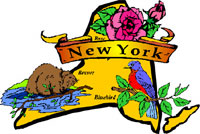
Worksheets and No Prep Teaching Resources
New York: "Ever Upward"
 Worksheets and No Prep Teaching Resources |
New York: "Ever Upward" |
| edHelper's suggested reading level: | grades 4 to 6 | |
| Flesch-Kincaid grade level: | 9.47 |
| Print New York: "Ever Upward" (font options, pick words for additional puzzles, and more) |
|
| Quickly print reading comprehension |
|
| Print a proofreading activity |
| Leave your feedback on New York: "Ever Upward" (use this link if you found an error in the story) |
|
New York: "Ever Upward"
By DARCY PILAWSKI |

|
 1 New York State has a rich past, full of wonderful stories and famous people. The first human settlement took place around 10,500 B.C., after the Ice Age. These first inhabitants who were hunters and gatherers later became farmers.
1 New York State has a rich past, full of wonderful stories and famous people. The first human settlement took place around 10,500 B.C., after the Ice Age. These first inhabitants who were hunters and gatherers later became farmers.